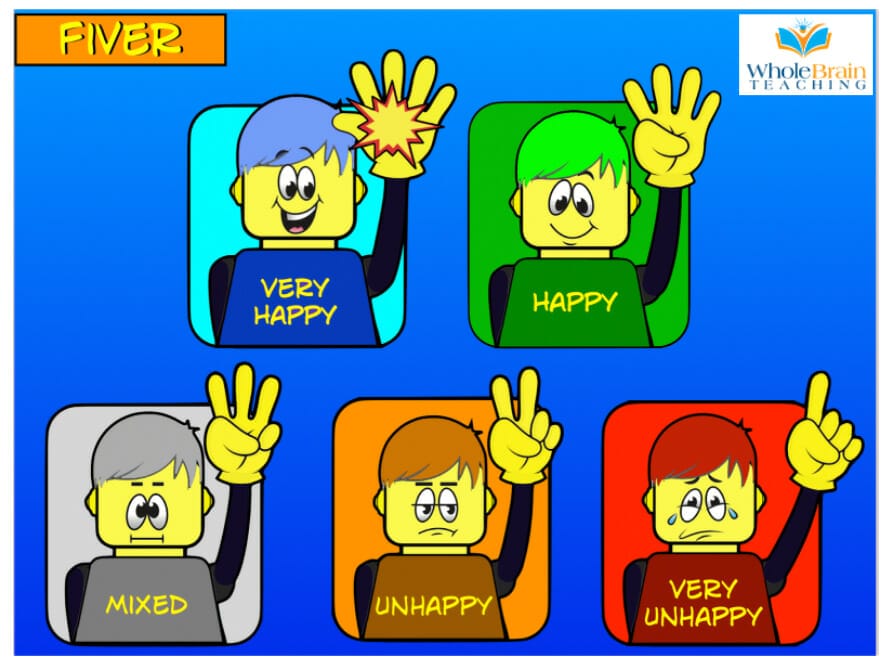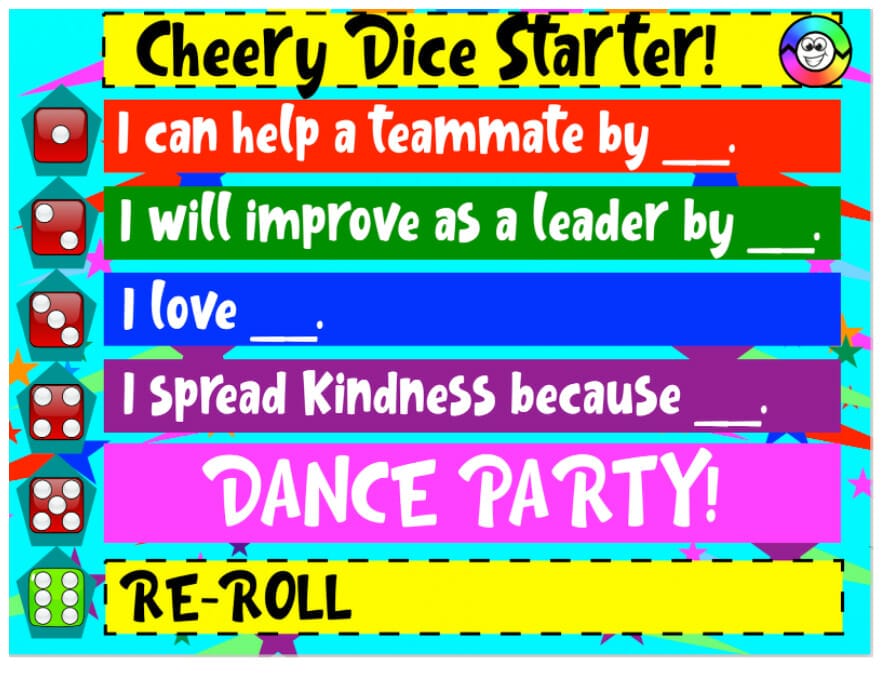Fiver and Cheery Dice
Simple strategies to embed Social/Emotional Learning into every lesson, everyday.

Every morning Ms. Maestra stands at her classroom door. She wants, more than anything, to know how her kids are feeling. Putting their fingers on their chest for privacy, students use Fiver to rate their current mood.
Kids who are Very Unhappy put one finger on their chest. If they are Unhappy, they put two fingers on their chest and so on up to Very Happy. Students who are Very Happy waggle their hands (the star explosion in Very Happy’s palm). The joy of hand waggling, in itself, is sometimes enough to make kids decide they are feeling wonderful.
Ms. Maestra smiles, makes eye contact, and offers a hug. She remembers her dismal first year of instruction when she realized on the last day that some students never looked in her eyes.

Our Guide knows there is no way to immediately lift the mood of a child who self-scores a 1 or 2. She makes a mental note to offer her student extra affection during Teach-Okay, in the morning’s first lesson.
Fiver has several virtues. The game only takes a few minutes, provides rapid insight into students’ feelings, creates a welcoming bond between instructor and class, and teaches the valuable psychological skill of mood self- assessment.
One of the central principles of emotional health is this: we have moods, moods don’t have us. It is one thing to suffer from a negative feeling; it is another to rate a feeling’s intensity. Scoring yourself a 1, Very Unhappy, is slightly, but crucially different than feeling Very Unhappy. Subjective pain becomes objective self assessment... for kids, a tiny, but positive step forward into a new day of learning.
Fiver should be played first thing in the morning and also whenever kids enter the room. Students live on a teeter-totter; we need to know whether they are up, down, or balanced in the middle.
Some teachers use a variation of Fiver as a comprehension assessment. After a challenging lesson on, for example, reducing fractions, Ms. Maestra says, “Show me five fingers if you’re ready to teach our fraction lesson to your neighbor, three fingers if you think you understand, one finger if you’d love to hear the lesson again.” She finds this rating superior to traditional instruction, “Everyone understand? Any questions?” Too often, asking if there are any questions from your class, produces the fear of being revealed as someone who didn’t understand the subject.
ee.

Follow up Fiver, by rolling the dice for Cheery Dice. The number rolled sets the activity.
Pairs of kids take turns filling in the sentence frame, giving each other 10 finger woos for creative ideas … or everyone dances for a minute! As the game is played, circulate the room and give needed affection to students who self-scored a 1 or 2 in Fiver.
Cheery Dice is a remarkably powerful minute that
– generates social emotional insights
– deepens bonds
– sets goals
– develops language arts skills
– nourishes creativity
– increases student energy
– creates opportunities for lifting student moods
During Cheery Dice, walk the room, praising kids for their interchanges or prompting them for deeper engagement with their neighbor. Most importantly, give extra affection to kids who scored 1 or 2 on Fiver.
If you have kids who throw disruptive tantrums, Cheery Dice provides perfect opportunities to give them special attention.
Revisit Cheery Dice several times a day, especially after recess and lunch. Let’s replace Brain Breaks with Cheery Breaks! Find more variations to play Cheery Dice in WBT 2024.

After Cheery Dice, place a thumbs up on your chest. Ask kids to mimic your gesture if their mood improved since playing Fiver and Cheery Dice.
Volunteers share the reason for their mood improvement.
Finally, share your own Fiver score when you started school … and its current state. Don’t burden children with anything negative you’re enduring but do explain your strategies for lifting your mood.
These three games, Fiver, Cheery Dice, and Fiver Plus, help kids enormously. They assess their mood, have an uplifting interchange with a classmate, and discover a core human truth … engaging in pleasant, social activities lifts our spirit!